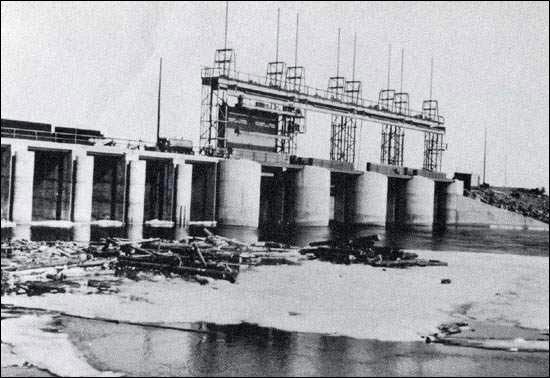Country Canada Opening date 1954 Impounds Ashuanipi River Catchment area 19,166 km² Construction began 1951 | Status Operational Type of dam Barrage dam Opened 1954 Turbine 1 | |
 | ||
Similar Churchill Falls Generatin, Churchill Falls, Lake Saint‑Louis, Assiniboine Park Zoo, Reptilia | ||
The Menihek Hydroelectric Generating Station is a conventional hydroelectric generating station at Menihek Lake in Labrador. The dam and powerhouse are located in the Canadian province of Newfoundland and Labrador, 40 km (25 mi) south of the isolated town of Schefferville, Quebec and two First Nations communities: Matimekosh-Lac-John and Kawawachikamach. The generating station, two 69 kV power lines and the distribution networks in each community form an independent electricity network, off the main North American grid.
Contents
- Map of Menihek Hydroelectric Generating Station Division No 10 Subd D NL Canada
- Geography
- History
- Dam and powerhouse
- Works cited
- References
Map of Menihek Hydroelectric Generating Station, Division No. 10, Subd. D, NL, Canada
Geography
The power development is located approximately 170 km (110 mi) north of Labrador City, Labrador, in an unhabitated region in the northwestern tip of Labrador. The station is just south of the Laurentian Divide between the Atlantic and Arctic drainage basins which delineates the Quebec–Newfoundland and Labrador border in the area. The climate in Schefferville, 40 km (25 mi) north of Menihek, is characterized by an average temperature of −5.3 °C (22.5 °F) — which can drop as low as −51 °C (−60 °F) in the winter and rise to 34 °C (93 °F) in the summer. The average frost-free period lasts from mid-June to mid-September. The area receives on average 833 mm (32.8 in) of precipitation, roughly divided between rain and snow.
The terrain in this remote area is rugged and the dam is only accessible by a narrow dirt road from Schefferville. A 2002 Hydro-Québec report described the road as in need of urgent repairs.
History
The facilities were built between 1951 and 1954 by the Iron Ore Company of Canada to meet the power requirements of its iron ore mining operations at the Knob Lake site, near the company town of Schefferville. After IOC closed the mine in 1982, it kept the generating station running for two decades. However, in the early 2000s, the mining company gave notice to the Government of Quebec that it would cease to operate the plant and electric network as of November 1, 2002. In a last-minute deal, Hydro-Québec agreed to pay for all charges incurred by IOC to run the money-losing network while the governments of Quebec and Newfoundland and Labrador and the Native communities tried to reach a deal on a mutually acceptable way to split the assets.
A milestone was reached by the two provinces and their respective utilities on December 14, 2005. IOC would sell all interests in the generating station and part of the transmission lines to provincially owned Newfoundland and Labrador Hydro (NLH), as is, for $1, while transferring its Quebec utility operations to Hydro-Québec for the same amount. Under the deal, the generating station would be operated by NLH employees, but it would be managed by a 4-person operating committee staffed by personnel of both utilities.
Under the 40-year contract, Hydro-Québec is responsible for any operation, maintenance and refurbishment costs of the network's facilities owned by NLH and agrees to buy a firm volume of 40 GWh/year at 3¢/kWh with the remainder at 2¢. Rates are adjusted to the consumer price index for the duration and NLH has the right to recall power and break the contract with a 6-year notice. The agreement was finalized on November 15, 2007.
Dam and powerhouse
The power development at the Menihek site includes a 228.6 m (750 ft) concrete gravity dam, a water intake, the powerhouse and a 4-gate spillway, with a capacity of 4,247 m3/s (150,000 cu ft/s).
The impoundment of Menihek Lake, which serves as a reservoir, is completed by three rock-fill dikes made of glacial till, for a total length of 6.2 km (4 mi). The Tshiuetin Rail Transportation shortline railway (formerly the Menihek Subdivision of the Quebec North Shore and Labrador Railway) connecting Schefferville and Sept-Îles uses the dikes to cross the area.
The powerhouse was designed to receive four generating units but only two were installed when the plant came on stream in 1954. Units 1 and 2 are equipped with fixed-blade propeller-types turbines and each have a capacity of 4,400 kW at a nominal hydraulic head of10.4 m (34 ft). Each turbine is coupled to a 5,000 kVA alternator. In 1960, IOC added unit 3, a 9,900-kW Kaplan turbine under a 12 m (39 ft) head and its 12,000 kVA alternator.
